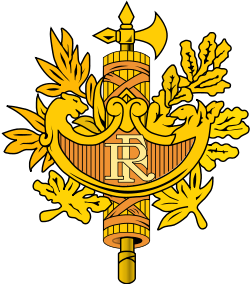Embassy of France, Ottawa
| Embassy of France in Ottawa | |
|---|---|
|
The French Embassy serves as both chancery and ambassadorial residence | |
| Coordinates | Coordinates: 45°26′36″N 75°41′40″W / 45.443356°N 75.694481°W |
| Location | New Edinburgh, Ottawa |
| Address | 42 Sussex Drive |
| Ambassador | Philippe Zeller |
The Embassy of France in Ottawa is the diplomatic mission of France to Canada, located at 42 Sussex Drive in the New Edinburgh neighbourhood of Ottawa.
History
The French diplomatic mission in Canada was founded in 1928 and was originally based in the Victoria Building with the first representative being Jean Knight.[1] Knight began looking for a suitable location to house the mission and settled on the area bordering the Ottawa River near Rockcliffe Park. Unfortunately there were no buildings in the area for sale. In 1930, Knight proposed the purchase of the Blackburn property, located at 62 Sussex Drive. The property was a prized piece of land overlooking the Rideau Falls that was not far from the residence of the Governor General and, at the time, connected to the city centre by a tram. After lengthy negotiations with the owner, the property was purchased from Arthur Blackburn on 31 December 1931. The legation was then based in the Blackburn mansion.[1]
Construction on the new mission building began on the property in 1936 with the first stone being laid by Prime Minister William Lyon Mackenzie King on Bastille Day.[2] In January 1938, while construction was in process, France purchased the next door Lemay property, sensibly enlarging the property.[1] At the same time, France acquired, for one symbolic dollar, a narrow strip of land along the Ottawa River, belonging to the Ontario provincial government.[1] The Ottawa River thus became the limits of the property. Both the Blackburn and Lemay houses were demolished during construction.[1] On 4 January 1939, the mission was opened in the presence of seven hundred people, including the Governor General of Canada Lord Tweedsmuir and Prime Minister Mackenzie King.[2]
The French envoy René Ristelhueber, appointed in early 1940, acknowledged the Vichy regime as did the Canadian government. In 1942, Canada switched and expelled the Vichy diplomats and the facilities were turned over to the Free French Forces and Colonel Philippe Pierrené was recognized as the French envoy. The French upgraded the mission to a full embassy following World War II.
Building
Inaugurated in 1939, this diplomatic mission was designed by French architect Eugène Beaudouin in the Art Deco style. Housing both the residence of the ambassador and embassy services, the building of grey granite is three stories and is organized around the Great Hall.
The main room features furniture and decorations also in an Art Deco style, including Marcel Gromaire tapestries representing the four seasons: the Canadian winter, the Parisian spring, summer in Saint-Malo and fall in Quebec. A massive pink marble staircase provides access to the second story and leads to the gallery overlooking the Great Hall and reception rooms.
The rooms display decorations that highlight the ties of friendship which exists between the France and Canada, like the bas-relief of the gallery that represents the Canadian National Vimy Memorial in honour of Canadian soldiers during the First World War and the office walls ambassadors engraved by Charles-Émile Pinson on the subject of the discovery of Canada by the Vikings. The materials that were used to build the embassy come from both Canada (wooden doors and door frames, and the grey granite from Quebec for exterior walls) and France (Saint-Quentin travertine for walls of the hall, and the pink marble from Burgundy for the staircase).
The dining room is decorated with a 120 square metre mural named La France, by painter Alfred Courmes. The decoration of the bronze doors of the living room was done by Robert Cami. The embassy is also decorated with sculptures by Leygue Louis and Jean Prouvé.
French Ambassador to Canada
| From | To | Ambassador |
|---|---|---|
| Envoy Extraordinary and Minister Plenipotentiary | ||
| 1928 | 1930 | Jean Knight |
| 1930 | 1932 | Charles-Arsène Henry |
| 1934 | 1937 | Raymond Brugère |
| 1937 | 1940 | Robert de Dampierre |
| 1940 | 1942 | René Ristelhueber |
| Delegate of Free French Forces | ||
| 1942 | 1943 | Colonel Philippe Pierrenne |
| 1943 | 1945 | Gabriel Bonneau |
| Ambassador of France to Canada | ||
| 1945 | 1948 | Jean de Hauteclocque |
| 1948 | 1949 | Francisque Gay |
| 1949 | 1955 | Hubert Guérin |
| 1955 | 1962 | Francis Lacoste |
| 1962 | 1965 | Raymond Bousquet |
| 1965 | 1968 | François Leduc |
| 1968 | 1972 | Pierre Siraud |
| 1972 | 1977 | Jacques Viot |
| 1977 | 1979 | Xavier Daufresne de la Chevalerie |
| 1979 | 1981 | Pierre Maillard |
| 1981 | 1984 | Jean Beliard |
| 1984 | 1987 | Jean-Pierre Cabouat |
| 1987 | 1989 | Philippe Husson |
| 1989 | 1991 | François Bujon de l'Estang |
| 1992 | 1997 | Alfred Siefer-Gaillardin |
| 1997 | 1998 | Loïc Hennekinne |
| 1998 | 2001 | Denis Bauchard |
| 2001 | 2004 | Philippe Guelluy |
| 2004 | 2008 | Daniel Jouanneau |
| 2008 | 2011 | François Delattre |
| 2011 | present | Philippe Zeller[3] |
See also
References
External links
| Wikimedia Commons has media related to French Embassy, Ottawa. |

